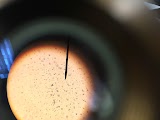As you remember, last week Devin and I preformed a Gram-Stain, and grew a culture of our unknown microbe on a Maconkey Auger. The results from these trials gave us evidence that our bacteria is a Gram-Positive bacteria. This means our microbe has a dense Peptidoglycan cell wall!
To further understand the makeup of our soil microbe's cell wall, this week we preformed an "Acid-Fast" Stain. The purpose of this stain is to determine if the cultured cells exhibit high lipid content cell walls (characteristic of all acid-fast bacteria). Specifically, the lipid in question is Mycolic Acid, which causes the cell walls of acid-fast bacteria to be waxy and very selective permeability.
Identifying this trait is helpful in identifying bacteria, because only a few genera of bacteria possess the acid‐fast property, Nocardia and Mycobacterium. This trait is also great for identifying many medically important bacteria, such as Mycobacterium tuberculosis, the causative agent of tuberculosis.
So, with that lets discuss how the Ziehl-Neelsen Method of acid-fast stain works.
Why Acid Stain?
- Acid-fast bacteria have a waxy and nearly impermeable cell wall, due to the aforementioned mycolic acid.
- Water based stains (such as the Gram stain) are unable to adequately penetrate this waxy mycolic acid.
- The Waxy Layer must be removed by heat to stain the cell.
Methodology-
- Create a smear using a drop of water and a dab of cultured microbe.
- Place slides over beaker of steaming water for 1 minute.
- While over the beaker, flood the slide with Carbol-Fuchsin, and allow to sit over steam for 5 minutes.
- Allow the slide to cool after 5 minutes and rinse with tap water.
- Add acid alcohol to the slide until color no longer runs from the smear.
- Rinse with tap water.
- Flood with methylene blue and allow to react for 1 minute.
- Rinse with tap water and blot dry.
- Examine with microscope.
- The Primary stain (pink) is driven into acid-fast cells during the heating period
- When cooled, Acid-Alcohol is applied to remove Carbol fuchsin from cells without mycolic acid.
- Crystal violet counterstain infiltrates bacterial cell walls that do not contain mycolic acid. (similar to a gram stain)
- Acid Fast= Pink
- Non-Acid-Fast= Purple
 |
| An example of ideal results of an Acid-fast Stain. Photo: http://imc02.hccs.edu/BiologyLabs/Micro/01MicrobialMorphologyStaining/01BacterialStaining.html |
Dirty Results
 |
| As it can be seen in the picture above, our results actually found a grey area between acid-fast and non-acid-fast. When compared to the ideal examples of acid-fast and non-acid-fast stains, our unknown microbe seems to be a perfect fit in-between both colors. (Maybe it's like #thedress an it's really white and gold?) We can not say with confidence whether our bacteria is acid-fast or not, but to me it seems the cell walls of the bacteria are a bit closer to blue than pink, so tentatively we will say our bacteria is non-acid-fast until further experiments are conducted. |
With the results we have collected so far we can begin to attempt to use a dichotomous key to narrow down the possible identities of our microbe.
Dichotomous Key results:
- Gram Positive
- Bacilli
- Non Acid-Fast
- Catalase positive or negative?
Tune in next time as we preform our catalase and carbohydrate test!
You Stay Classy San Diego
Information on the science of Acid-Fast Staining was obtained at the following site:
http://www.scienceprofonline.com/microbiology/acid-fast-ziehel-neelsen-bacteria-stain-identify-mycobacteria-nocardia.html
No comments:
Post a Comment